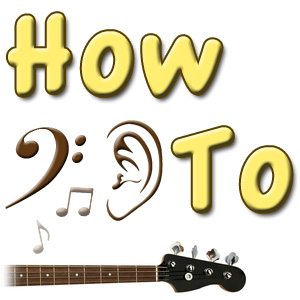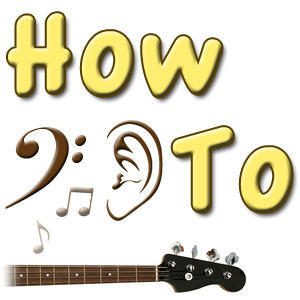 Bass players get a hard rap among musicians.
Bass players get a hard rap among musicians.
Just four strings? It must be easier than guitar.
Playing from tab rather than sheet music? You must not be smart enough for “real” notation.
Whatever.
One thing that bass players often have better than anyone else in the band: a good ear.
Bassists bridge the gap between rhythm (drummer) and pitch (guitar, vocals).
They need a blend of skills, and the ear to match.
That means that unlike some instruments where there’s one obvious area of ear training to focus on, bassists really must acquire and improve a number of key listening skills.
1. Creating Bass Lines
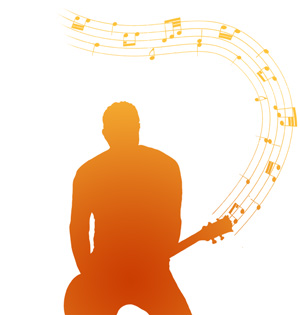 If you’re writing songs, creating music in a band, playing jam sessions, or improvising solos, as a bassist you need to understand what makes bass lines work, musically.
If you’re writing songs, creating music in a band, playing jam sessions, or improvising solos, as a bassist you need to understand what makes bass lines work, musically.
It’s not enough to just memorise the bass part to the songs you expect to play. You need to be able to create compelling basslines yourself, on demand, as the musical situation requires.
Do you understand what makes your favourite bass lines so great? Can you hear what distinguishes one style of bass line from another? Ear training can help you unlock the secrets lurking in those killer bass riffs.
What does that mean, specifically? Here are some ear training exercises you can do to improve your bass lines:
Chord Progressions Ear Training
 The bass is the foundation for the chords and harmony of music. Often that means supplying the root note of the chord, but as you probably know, there’s much more to it than that.
The bass is the foundation for the chords and harmony of music. Often that means supplying the root note of the chord, but as you probably know, there’s much more to it than that.
Bass guitarists need to know what chords are being played, and how those chords relate to another in the context of the musical key. You may know your riff, but do you know why those notes are being used? Can you hear the underlying I-IV-V progression. Do you know why that note you play in the chorus suddenly gives the song a melancholy feel?
Progressions ear training can teach you how your bass lines relate to the rest of the music, and really understand your role in the harmony.
Also essential if you get called in to play with a band at the last minute. You don’t have time to memorise their set list and you can’t be reliant on song sheets up on stage—but if you can hear the chord progression you can improvise your bass part without a hitch.
Interval Ear Training
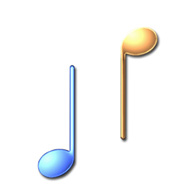 One way to pick apart the basslines and riffs you play is to dissect them into their component intervals. As a bassist you’re probably used to the fretboard patterns which correspond to thirds, fifths and octaves, for example.
One way to pick apart the basslines and riffs you play is to dissect them into their component intervals. As a bassist you’re probably used to the fretboard patterns which correspond to thirds, fifths and octaves, for example.
Interval ear training teaches you to recognise these different musical intervals by ear, and improves your vital sense of relative pitch. This is a powerful way to help you start improvising bass riffs and solos, because you know before you play the notes exactly how they’ll sound.
Don’t just make guesses based on fretboard patterns you know are “safe” to play. Use interval ear training to connect the music you imagine in your head with your bass guitar, so you can play what you mean to play.
Scale Degrees Ear Training
 Complementary to chord progressions and learning intervals, studying relative pitch in terms of scale degrees gives you a clear sense of where the notes you play belong in the key. Each note of the scale has a role to play, musically, and if you want to have a particular impact with your playing, scale degree ear training will tell you which notes you need to do it.
Complementary to chord progressions and learning intervals, studying relative pitch in terms of scale degrees gives you a clear sense of where the notes you play belong in the key. Each note of the scale has a role to play, musically, and if you want to have a particular impact with your playing, scale degree ear training will tell you which notes you need to do it.
Solfège is a popular approach, where each note in the scale has a “name”, but simple numbering systems are useful to. This works in tandem with knowing intervals, so that you can think “I want to jump up a major third from here” or “If I play the major sixth of this chord it’s going to sound great”.
2. Playing bass by ear
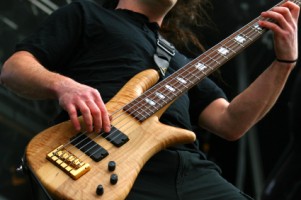 The next area of ear training to think about as a bassist is playing by ear. This is more an activity than a particular skill: it draws on several areas of ear training.
The next area of ear training to think about as a bassist is playing by ear. This is more an activity than a particular skill: it draws on several areas of ear training.
If you want to be able to play the bass part of songs by ear, or make up basslines to suit a song, you’ll need to spend some time practising playing bass by ear.
The overall approach of play-by-ear ear training boils down to: Try it. Improve. Repeat.
It really is as simple as that, but there are ways to accelerate your progress. Use relative pitch ear training to help you make better guesses at the notes to play, practice active listening to become more musically conscious, and dedicate practice time every day to playing bass by ear.
Another thing which can help is to learn common bass riffs and runs, which builds up your vocabulary. In a way this is the same as interval ear training (teaching your brain to know what the sequences of notes you hear are) but in larger “chunks”. You may hear a particular riff you already know being used, or simply realise “oh, this is a bit like that other riff”, but either way, having a repertoire of bass licks, riffs and runs can make it much quicker to jump to the right answer when playing bass by ear
C. Bass Tone and Bass Effects
As well as which notes to play, you need to think about your overall bass sound. This is an important part of integrating with a band as well as having your own distinctive style.
We have a whole series dedicated to bass tone here on EasyEarTraining.com, but here are three quick pointers for thinking about your bass tone:
- The instrument itself.
Do you play electric bass or an upright/double bass? Does your bass guitar fundamentally create the right kind of sound for the music you play? Is it a high quality instrument that will allow you to produce a high quality sound? - Your tonal balance.
Use the bass, mid and treble controls on your bass guitar and amp to get the right basic balance of bass and treble. This has a huge impact on your presence in the mix. Playing slap bass? You’re gonna want some treble for those “pops”. Playing low down in a reggae band? Crank that bass dial. - Audio effects. This is where things can get wild and wacky. Use these in moderation, and adjust them to suit the particular song, but don’t be afraid to draw on a range of audio effects to achieve the musical impact you’re looking for.
All three of these areas are about choosing and using equipment well—but that is entirely dependent on your ability to listen critically to the sound you’re producing, having done appropriate bass tone ear training to distinguish good from bad, and better from best.
4. Your Sense of Rhythm
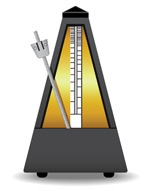 Some people pick up a bass because they seem to have a good natural sense of rhythm. Others have to learn it along the way. Whichever you are, one thing’s for certain: Improving your sense of rhythm will make you a better bassist.
Some people pick up a bass because they seem to have a good natural sense of rhythm. Others have to learn it along the way. Whichever you are, one thing’s for certain: Improving your sense of rhythm will make you a better bassist.
Even with a strong sense of relative pitch, great play-by-ear skills and the perfect bass tone, if your sense of rhythm is weak, nobody will want to listen to you play.
Fortunately, rhythm ear training can help you hone your rhythmic abilities and learn to be a vital part of a strong rhythm section.
Rhythm ear training breaks down into a number of areas, including:
- Estimating tempo
It can be down to you to set the tempo for a song, or lead tempo changes. Tempo ear training can help you reliably estimate and judge tempos. - Maintaining a steady beat
Once the tempo is set, you need to be rock-steady keeping the beat. - Playing with the beat
A benefit of having a rock-solid sense of beat is that it gives you the freedom to play around with it slightly. Anticipating the beat, playing ghost notes, accenting the right beats—these ways of playing with the beat on a small scale can all add energy and keep the rhythm exciting. - Synchronising well with a drummer
Bassist and Drummers work together to provide the rhythm in most bands, and you need to act as one. Even if you both have a great sense of rhythm, unless you’re operating in tandem, the rest of the band and your audience are going to be unsettled and musically irritated.
Don’t fall into the trap of thinking these are skills which will just develop naturally; they will, but slowly. Use rhythm ear training to become a better bass player faster.
Bass Ear Training Summary
Bass players need a strong ear in several different areas, and each can be improved with specific ear training exercises. If you want to become a better bassist: work on your relative pitch, practice playing by ear, develop your tone, and upgrade your sense of rhythm.
So next time someone makes fun of bassists, you can smile contentedly in the knowledge that there’s a great deal more to playing bass guitar than plucking out root notes in the background…
But then, you knew that already, right?

